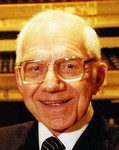Leo L. Beranek
- Birthdate
- 1914/09/15
- Birthplace
- Solon, IA, USA
- Death date
- 2016/10/10
- Associated organizations
- Bolt Beranek and Newman Inc
- Fields of study
- Computing
- Awards
- IEEE Founders Medal, U.S. National Medal of Science
Biography
For more than seven decades, Leo L. Beranek has made impactful contributions to acoustics and engineering as a scientist, author, teacher, and as an innovative leader of academia, scientific organizations, industry, and the arts.
Dr. Leo Leroy Beranek was born in Solon, Iowa, on 15 September 1914. From an early age, Beranek took an interest in anything mechanical or electrical, especially radios. He received the B.A. degree from Cornell College, Mt. Vernon, Iowa, in 1936, the M.S. and Sc.D. degrees in applied physics from Harvard University, in 1937, and 1940, respectively, and an honorary D.Sc. degree from Cornell College in 1946.
After receiving his doctor of Science degree in 1940, Beranek ran Harvard's Electronic Acoustic Laboratory. In the former he played a major role in improving voice communications and reducing noise in combat aircraft, and in the latter fending off the Kamikaze threat, work for which he was later honored by President Truman. Beranek then left Harvard for Massachusetts Institute of Technology, to teach teach communications engineering and run the Acoustics Laboratory. He received many business demands, and would then leave his position from MIT, to fun a consulting firm with physicist Richard Bolt and architect Robert Newman.
In 1948, Beranek and Richard Bolt founded Bolt Beranek and Newman Inc. (BBN), a high-tech company with roots as an acoustical consulting firm that evolved into an important contributor of computer innovations. Under Beranek’s leadership, BBN pioneered the development of ARPANET, which was the precursor to today’s Internet. Known for a keen ability to recognize and engage the best talent for the task at hand, Beranek brought to BBN leaders in acoustics, artificial intelligence, computer science, and underwater sound. His accomplishments with BBN include designing the sound system for the United Nations General Assembly Hall. He developed noise standards for jet airplanes during the 1950s that required planes to implement noise-reducing mufflers and alter take-off flight patterns. He helped set the standards for acceptable noise levels in office buildings, schools, and factories. Beranek also served as acoustical design consultant for concert halls and opera houses around the world, including the Tokyo Opera City Concert Hall, praised on the front page of the New York Times (April 18, 2000) as "an acoustical miracle." In the 1970s, he would put up his life savings in an FCC contest, obtaining a license to operate Boston's WCBV-TV, Channel 5. Beranek has also been active in civic organizations, serving as Chairman of the Boston Symphony Orchestra, member of the Harvard Board of Overseers, and President of the World Affairs Council of Boston. From 1989 to 1994, he was President of the American Academy.
An IEEE Life Fellow, Beranek’s honors include gold medals from the Acoustical Society of America (1975) and the American Society of Mechanical Engineers (2004) and the U.S. National Medal of Science (2003). In 2013 he received the IEEE Founders Medal "For leadership as a co-founder of a premier consulting firm that shaped modern acoustical practice and laid the groundwork for the Internet, and for public service." Beranek is the founder (retired) of Bolt Beranek and Newman (now Raytheon BBN Technologies), Cambridge, MA, USA.
Beranek is a Fellow of the American Physical Society, a Fellow and Associate Editor of the Acoustical Society of America, a Senior Member of the Institute of Radio Engineers, a Member of the American Association for the Advancement of Science, a Member of Sigma Xi, and a Member of Eta Kappa Nu. Ha has also served as Vice-President of the Acoustical Society of America, the Chairman of the Acoustics Section of the American Standards Association, and as Chairman of the Acoustics Panel of the Research and Development Board of the Department of Defense.
